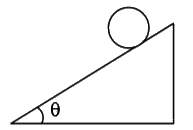A sphere starts rolling down can incline of inclination theta. Find the speed of its centre when it has covered a distance l.
The correct Answer is:A
To find the speed of the center of a sphere rolling down an incline after covering a distance l, we can follow these steps:
Step 1: Understand the Geometry of the Problem
The sphere rolls down an incline with an angle θ. When it has traveled a distance l along the incline, the vertical height h from which it has descended can be calculated using the sine function:
h=lsinθ
Step 2: Apply the Work-Energy Theorem
The work-energy theorem states that the work done by the gravitational force is equal to the change in kinetic energy of the sphere. The gravitational force does work as the sphere descends, converting potential energy into kinetic energy.
The work done by gravity as the sphere descends a height h is:
W=mgh=mg(lsinθ)
Step 3: Write the Kinetic Energy Expression
The kinetic energy of the sphere consists of two parts: translational kinetic energy and rotational kinetic energy. The total kinetic energy K when the sphere is rolling is given by:
K=12mv2+12Iω2
For a solid sphere, the moment of inertia I is:
I=25mr2
Also, since the sphere rolls without slipping, we have the relationship:
v=ωrorω=vr
Step 4: Substitute and Simplify
Substituting I and ω into the kinetic energy expression:
K=12mv2+12(25mr2)(vr)2
This simplifies to:
K=12mv2+15mv2=710mv2
Step 5: Set Work Equal to Kinetic Energy
Now, according to the work-energy theorem:
mg(lsinθ)=710mv2
We can cancel m from both sides (assuming m≠0):
g(lsinθ)=710v2
Step 6: Solve for v
Rearranging the equation to solve for v2:
v2=107g(lsinθ)
Taking the square root gives us the speed of the center of the sphere:
v=√107glsinθ
Final Answer
Thus, the speed of the center of the sphere when it has covered a distance l down the incline is:
v=√107glsinθ
---
The sphere rolls down an incline with an angle θ. When it has traveled a distance l along the incline, the vertical height h from which it has descended can be calculated using the sine function:
h=lsinθ
The work-energy theorem states that the work done by the gravitational force is equal to the change in kinetic energy of the sphere. The gravitational force does work as the sphere descends, converting potential energy into kinetic energy.
W=mgh=mg(lsinθ)
The kinetic energy of the sphere consists of two parts: translational kinetic energy and rotational kinetic energy. The total kinetic energy K when the sphere is rolling is given by:
K=12mv2+12Iω2
For a solid sphere, the moment of inertia I is:
I=25mr2
Also, since the sphere rolls without slipping, we have the relationship:
v=ωrorω=vr
Substituting I and ω into the kinetic energy expression:
K=12mv2+12(25mr2)(vr)2
This simplifies to:
K=12mv2+15mv2=710mv2
Now, according to the work-energy theorem:
mg(lsinθ)=710mv2
We can cancel m from both sides (assuming m≠0):
g(lsinθ)=710v2
Rearranging the equation to solve for v2:
v2=107g(lsinθ)
Taking the square root gives us the speed of the center of the sphere:
v=√107glsinθ
Thus, the speed of the center of the sphere when it has covered a distance l down the incline is:
v=√107glsinθ
Topper's Solved these Questions
- BOOK - HC VERMA ENGLISHCHAPTER - ROTATIONAL MECHANICSEXERCISE - Questions for short Answer21videos
ROTATIONAL MECHANICS
- BOOK - HC VERMA ENGLISHCHAPTER - ROTATIONAL MECHANICSEXERCISE - Objective -214videos
ROTATIONAL MECHANICS
- BOOK - HC VERMA ENGLISHCHAPTER - REST AND MOTION : KINEMATICSEXERCISE - Question for short Answer13videos
REST AND MOTION : KINEMATICS
- BOOK - HC VERMA ENGLISHCHAPTER - SIMPLE HARMONIC MOTIONEXERCISE - Question for short Answer15videos
SIMPLE HARMONIC MOTION
Similar Questions
A sphere is rolling down a plane of inclination θ to the horizontal. The acceleration of its centre down the plane is
View SolutionA solid cylinder of mass m and radius r starts rolling down an inclined plane of inclination θ. Friction is enough to prevent slipping. Find the speed of its centre of mass when its centre of mass has fallen a height h.
View SolutionA solid cylinder of mass m and radius r starts rolling down an inclined plane of inclination θ. Friction is enough to prevent slipping. Find the speed of its centre of mass when its centre of mass has fallen a height h.
View SolutionA solid cylinder is rolling down a rough inclined plane of inclination θ. Then
View SolutionA sphere rolls down on an inclined plane of inclination θ. What is the acceleration as the sphere reaches bottom?
View SolutionA sphere rolls down on an inclied plane of inclination θ. What is the acceleration as the sphere reaches bottom ?
View SolutionA solid cylinder of mass M and radius R rolls down an inclined plane of height h without slipping. The speed of its centre when it reaches the bottom is.
View SolutionA spherical shell of radius R is rolling down an incline of inclination θ without slipping. Find minimum value of coefficient of friction.
 View Solution
View SolutionA sphere of mass m rolls without slipping on an inclined plane of inclination θ. Find the linear acceleration of the sphere and the force of friction acting on it. What should be the minimum coefficient of static friction to support pure rolling?
View SolutionA solid sphere of mass m rolls without slipping on an inclined plane of inclination θ. The linear acceleration of the sphere is
View Solution

